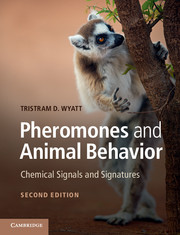Book contents
- Frontmatter
- Dedication
- Contents
- Preface to the second edition
- Acknowledgments
- List of SI prefixes
- List of Abbreviations
- 1 Animals in a chemical world
- 2 Methods for identifying and studying semiochemicals
- 3 Pheromones, chemical cues, and sexual selection
- 4 Coming together and keeping apart: aggregation pheromones and host-marking pheromones
- 5 Territorial behavior and semiochemicals
- 6 Semiochemicals and social organization
- 7 Pheromones and recruitment communication
- 8 Fight or flight: alarm pheromones and cues
- 9 Perception and response to chemical communication: from chemosensory receptors to brains, behavior, and development
- 10 Finding the source: pheromones and orientation behavior
- 11 Breaking the code: illicit signalers and receivers of semiochemicals
- 12 Using semiochemicals: applications of pheromones
- 13 On the scent of human attraction: human pheromones?
- Appendix An introduction to chemical terms for non-chemists
- References
- List of Credits
- Index
1 - Animals in a chemical world
Published online by Cambridge University Press: 05 June 2014
- Frontmatter
- Dedication
- Contents
- Preface to the second edition
- Acknowledgments
- List of SI prefixes
- List of Abbreviations
- 1 Animals in a chemical world
- 2 Methods for identifying and studying semiochemicals
- 3 Pheromones, chemical cues, and sexual selection
- 4 Coming together and keeping apart: aggregation pheromones and host-marking pheromones
- 5 Territorial behavior and semiochemicals
- 6 Semiochemicals and social organization
- 7 Pheromones and recruitment communication
- 8 Fight or flight: alarm pheromones and cues
- 9 Perception and response to chemical communication: from chemosensory receptors to brains, behavior, and development
- 10 Finding the source: pheromones and orientation behavior
- 11 Breaking the code: illicit signalers and receivers of semiochemicals
- 12 Using semiochemicals: applications of pheromones
- 13 On the scent of human attraction: human pheromones?
- Appendix An introduction to chemical terms for non-chemists
- References
- List of Credits
- Index
Summary
When two dogs meet and sniff, they gain a wealth of information from each other’s smells. Each dog will discover the sex, maturity, and hormonal state of the other; some of these smells will be species-wide dog pheromone signals. Each dog also detects the individual smell of the other, which it learns as a “signature mixture” to remember in case they meet again.
When two ants meet and sweep antennae over each other, they have an olfactory exchange of information similar to that of the dogs, discovering age, sex, ovarian stage (reproductive or not), and caste (worker, soldier, queen), all signals from species-wide pheromones. They also detect the colony odor of the other ant, enabling them to decide by the “signature mixture” whether the other ant is a nestmate or not.
All animals produce a chemical profile, present on the body surface, released as volatile molecules, and from scent marks that they deposit (by dogs on lamp-posts for example) (Figures 1.1, 1.2, 13.2). As chemical senses are ancient and widespread, shared by all organisms including bacteria, animals are pre-adapted to detect chemical information in the environment (Box 1.1). Across the animal kingdom, animals of all kinds gain chemosensory information from other organisms. Chemical senses are used to locate potential food sources and detect predators. Chemical senses also mediate the social interactions that form the focus of this book, as illustrated by the dogs and ants above. We can probably say that more organisms use chemosensory communication than any other mode.
- Type
- Chapter
- Information
- Pheromones and Animal BehaviorChemical Signals and Signatures, pp. 1 - 48Publisher: Cambridge University PressPrint publication year: 2014
- 2
- Cited by



